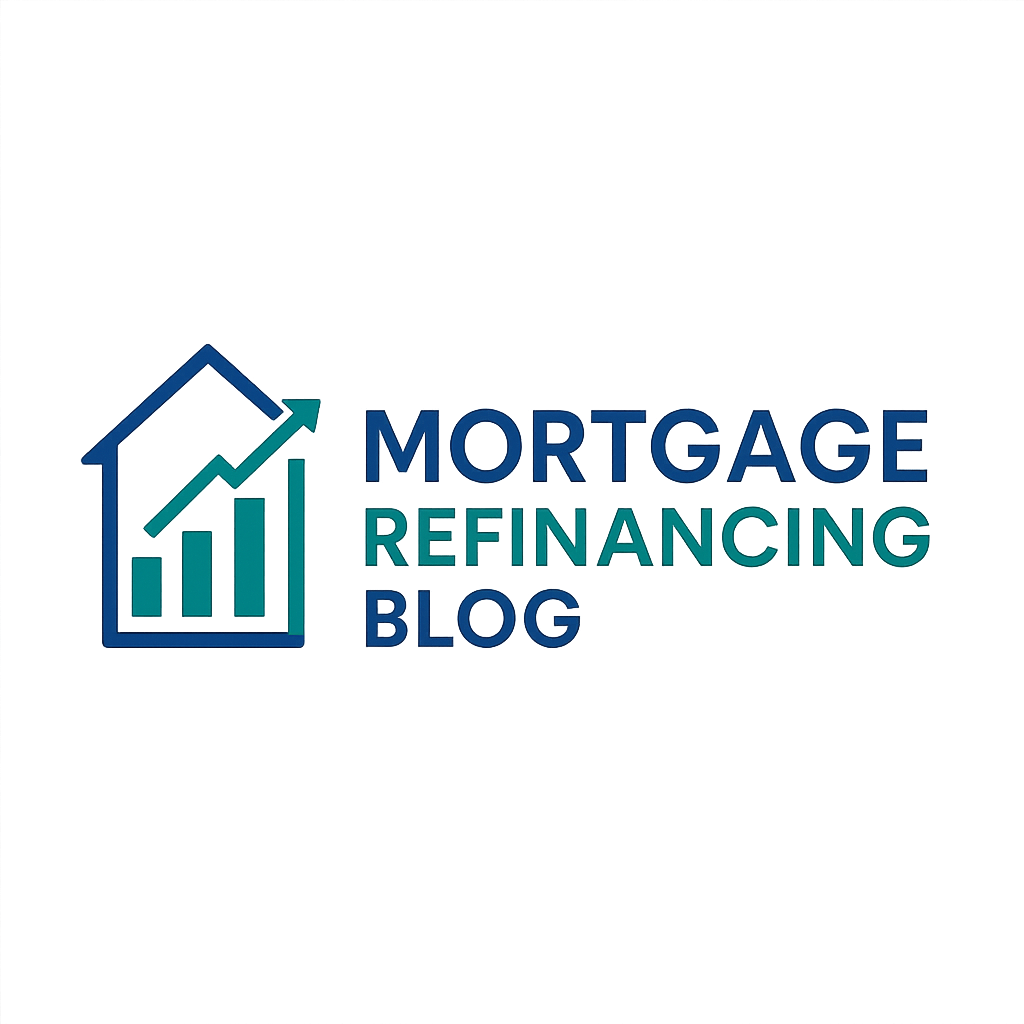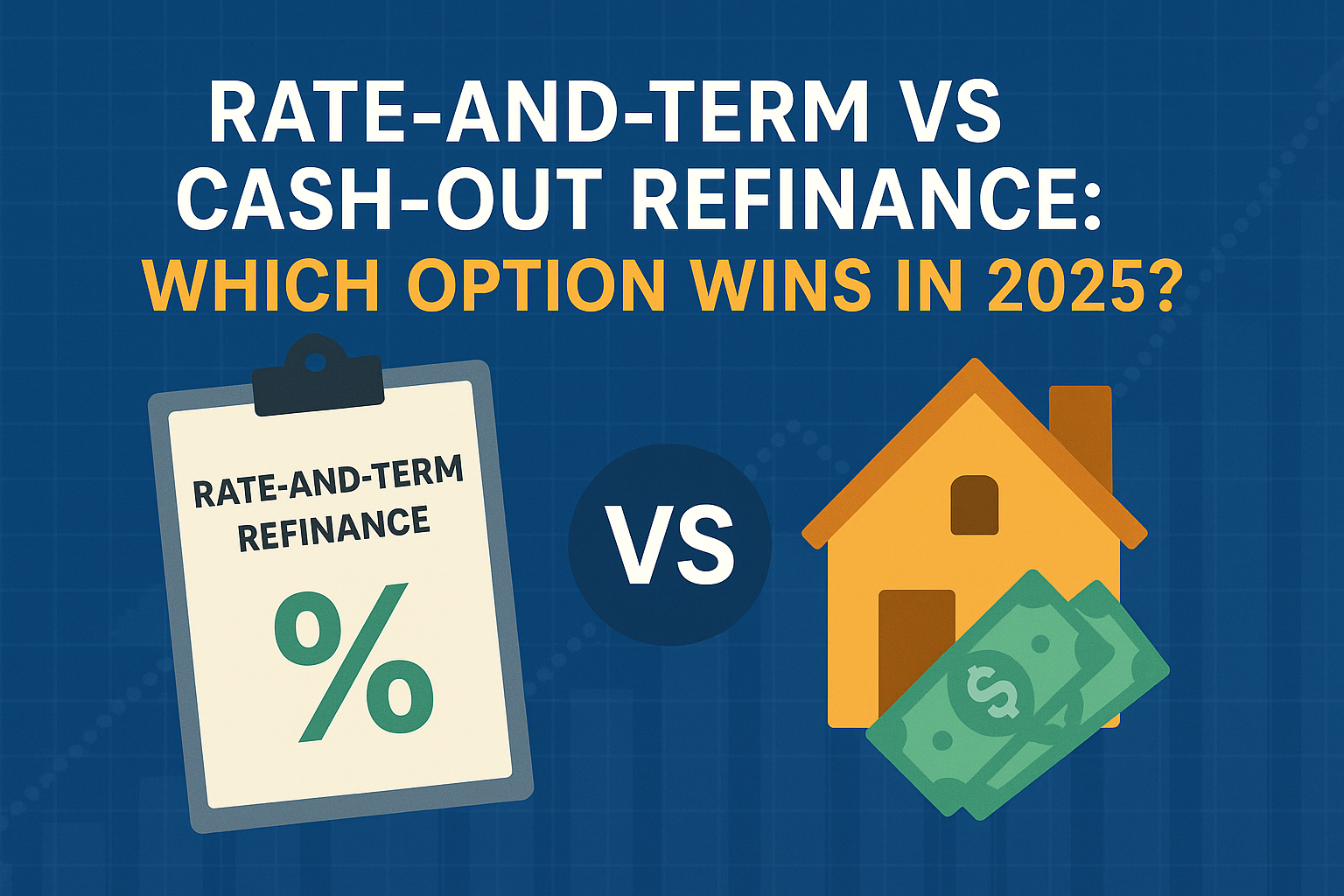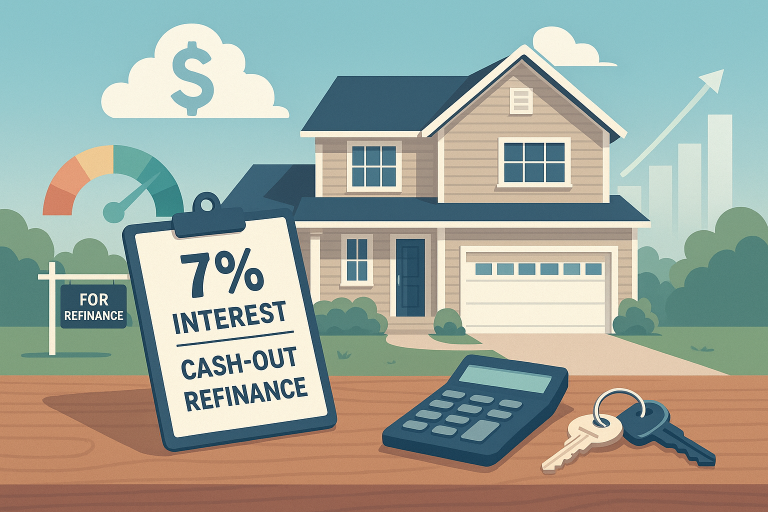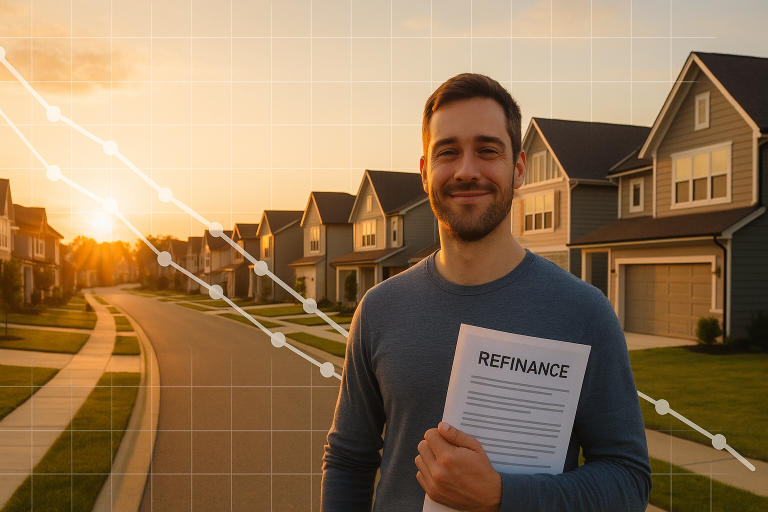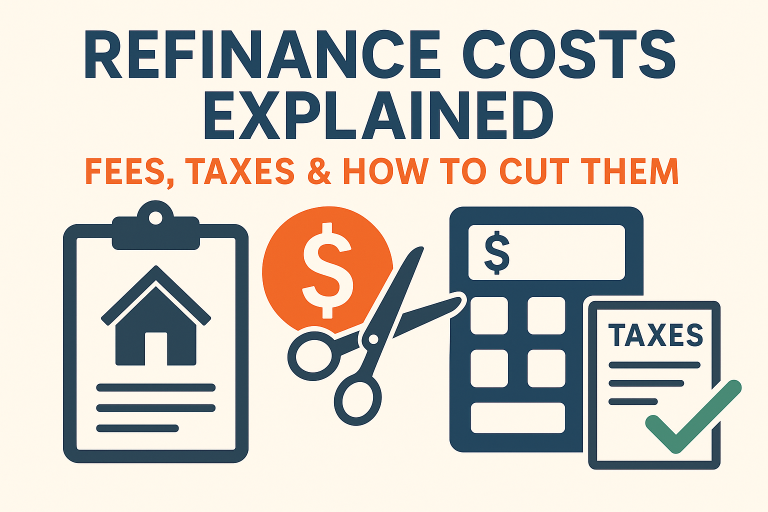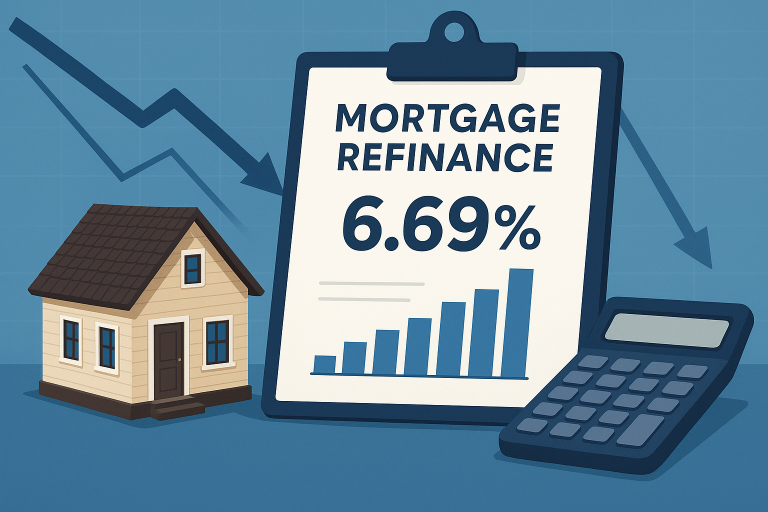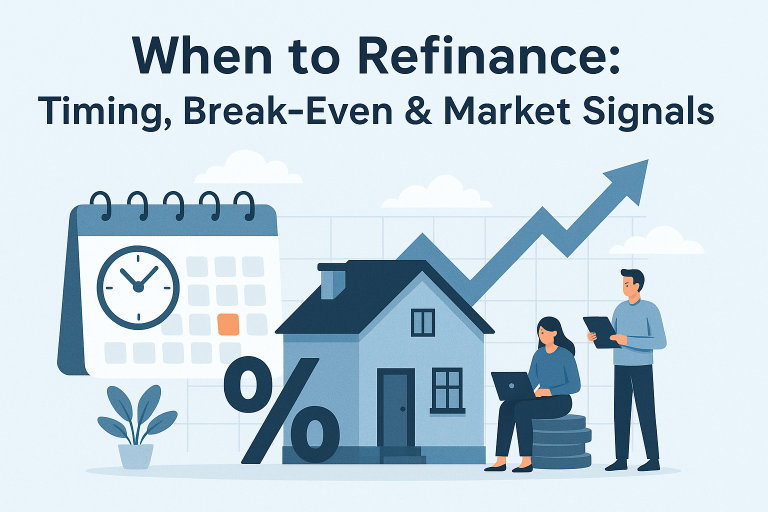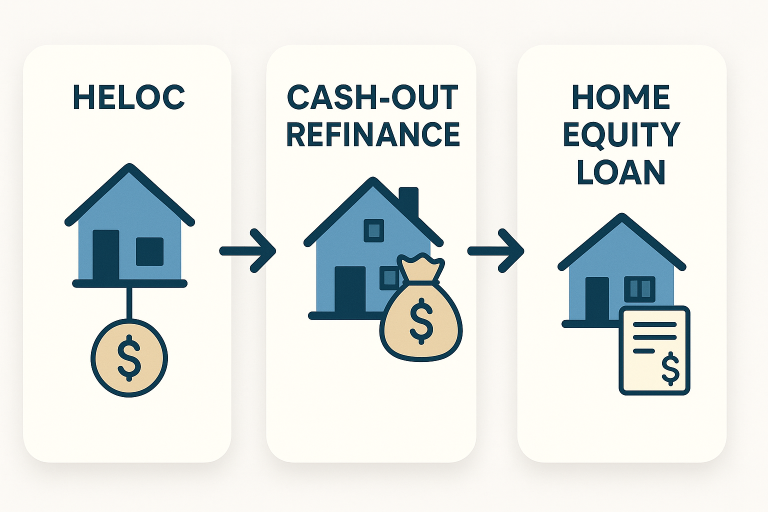Rate-and-Term vs Cash-Out Refinance: Which Option Wins in 2025?
The Stakes Are Higher Than Ever
In 2025’s volatile mortgage market, choosing between rate-and-term and cash-out refinancing isn’t just about interest rates—it’s about financial strategy. With average refinance rates hovering around 6.84% for standard refinancing and cash-out rates commanding premiums of 0.125% to 0.5% higher, the decision carries significant long-term consequences[1]. Current market conditions show refinances comprising 25% of all mortgage locks, with 13% being cash-out refinances specifically[2]. This choice determines not only your monthly payment but also your equity position, tax implications, and overall financial flexibility. The wrong decision could cost thousands in unnecessary interest or missed opportunities for wealth building.
Quick Definitions
Rate-and-Term Refinancing is the process of replacing your existing mortgage with a new loan that has different interest rates, loan terms, or both, without taking additional cash from your home’s equity. The new loan amount typically equals your current mortgage balance plus closing costs.
Cash-Out Refinancing involves replacing your current mortgage with a new, larger loan and receiving the difference in cash. This allows you to access your home’s equity for various purposes while potentially adjusting your rate and terms.
The key distinction lies in the loan amount: rate-and-term refinancing maintains or reduces your mortgage balance, while cash-out refinancing increases it. This fundamental difference affects everything from interest rates to qualification requirements and long-term financial implications.
How Each Type Works
Rate-and-Term Refinancing Process
Rate-and-term refinancing focuses purely on improving your mortgage terms. You apply for a new loan with the same or lower balance as your current mortgage. The process involves standard mortgage underwriting: credit checks, income verification, home appraisal, and debt-to-income analysis.
The new loan pays off your existing mortgage, and you begin making payments under the new terms. If you’re switching from a 30-year to 15-year mortgage, your monthly payments will increase but you’ll pay less interest over time. Conversely, extending your term reduces monthly payments but increases total interest paid.
Closing costs typically range from 2-5% of the loan amount, which can either be rolled into the new loan or paid upfront. The process usually takes 30-45 days from application to closing.
Cash-Out Refinancing Process
Cash-out refinancing involves more complex calculations and stricter requirements. You apply for a loan amount that exceeds your current mortgage balance, with the difference provided as cash at closing.
Lenders typically limit cash-out refinancing to 80% of your home’s value, though some programs allow up to 95%[3]. The process requires a comprehensive appraisal to determine your home’s current market value, as this directly affects how much cash you can extract.
The underwriting process is more stringent due to the increased risk to lenders. You’ll need higher credit scores, lower debt-to-income ratios, and more substantial income documentation. Interest rates are typically 0.125% to 0.25% higher than rate-and-term refinancing[4].
Ideal Borrower Profiles
Rate-and-Term Refinancing Candidates
The Rate Optimizer: Homeowners with mortgages above current market rates who want to reduce monthly payments or total interest costs. Ideal candidates have credit scores above 740 and stable income.
The Term Adjuster: Borrowers wanting to switch from 30-year to 15-year mortgages to build equity faster, or those extending terms to reduce monthly payments during financial transitions.
The ARM Escapee: Homeowners with adjustable-rate mortgages seeking fixed-rate stability, especially when ARM adjustment periods approach or rates are expected to rise.
The PMI Eliminator: Borrowers whose homes have appreciated enough to eliminate private mortgage insurance requirements through reduced loan-to-value ratios.
Cash-Out Refinancing Candidates
The Home Improver: Homeowners with substantial equity who want to fund renovations that increase property value. This group benefits from potentially tax-deductible interest on improvement-related cash-out proceeds.
The Debt Consolidator: Borrowers with high-interest credit card debt or personal loans who can achieve lower overall interest costs by consolidating into mortgage debt.
The Investor: Homeowners seeking to access equity for investment opportunities, whether real estate, business ventures, or other wealth-building strategies.
The Life Event Navigator: Families needing cash for major expenses like education, medical bills, or emergency funds, particularly when other financing options are more expensive.
Equity and Loan-to-Value Math
Understanding the Numbers
Loan-to-value (LTV) ratios are crucial in both refinancing types but calculated differently. For rate-and-term refinancing, LTV equals your new loan amount divided by your home’s current value. Most lenders prefer LTV ratios below 80% for optimal rates.
Rate-and-Term Example:
- Home value: $400,000
- Current mortgage: $280,000
- New loan amount: $280,000 (plus closing costs)
- LTV ratio: 70%
Cash-out refinancing LTV calculations include the additional cash you’re extracting:
Cash-Out Example:
- Home value: $400,000
- Current mortgage: $280,000
- Desired cash: $40,000
- New loan amount: $320,000
- LTV ratio: 80%
Equity Requirements
Rate-and-term refinancing typically requires 20% equity (80% LTV) for optimal rates, though programs exist for higher LTV ratios. Cash-out refinancing is more restrictive, with most conventional loans capping at 80% LTV, meaning you need at least 20% equity remaining after the cash-out.
Veterans Affairs (VA) loans offer more flexibility, allowing up to 100% LTV for rate-and-term refinancing and 90% for cash-out refinancing. Federal Housing Administration (FHA) loans permit up to 97.5% LTV for rate-and-term and 80% for cash-out refinancing.
The Equity Calculation Impact
Your home’s equity position affects both options differently. Rising home values benefit cash-out refinancing by increasing available cash, while declining values may eliminate cash-out opportunities entirely. Rate-and-term refinancing is less sensitive to value changes unless you’re near the LTV threshold for PMI removal.
Tax and Interest Rate Implications
Interest Rate Differences
Cash-out refinancing consistently carries higher interest rates than rate-and-term refinancing. Current market conditions show cash-out rates running 0.125% to 0.5% higher than standard refinance rates[5]. This premium reflects the increased risk lenders perceive in cash-out transactions.
On a $300,000 mortgage, a 0.25% rate difference translates to approximately $40 monthly and $14,400 over 30 years. This cost must be weighed against the benefits of accessing your equity.
Tax Considerations
Rate-and-Term Tax Implications: Generally straightforward, with mortgage interest remaining deductible up to IRS limits ($750,000 for mortgages originated after December 15, 2017). No additional tax implications arise from the refinancing itself.
Cash-Out Tax Implications: More complex but generally favorable. The cash you receive isn’t considered taxable income since it’s a loan[6]. However, interest deductibility depends on how you use the funds:
- Home improvements: Interest on cash-out proceeds used for home improvements remains deductible
- Other purposes: Interest on cash used for investments, debt consolidation, or personal expenses may not be deductible
- Business use: Cash used for business purposes may qualify for business interest deductions
Strategic Tax Planning
Cash-out refinancing offers strategic tax advantages when used for home improvements. The interest remains deductible, and improvements may increase your home’s value. However, using cash-out proceeds for non-home-related expenses eliminates the tax deductibility of that portion of the mortgage interest.
Risk and Reward Comparison
| Factor | Rate-and-Term Refinancing | Cash-Out Refinancing |
|---|---|---|
| Interest Rate | Lower (6.84% avg) | Higher (7.09% avg) |
| Closing Costs | 2-5% of loan amount | 2-6% of loan amount |
| Qualification Difficulty | Moderate | More stringent |
| Equity Requirements | 20% minimum | 20% minimum remaining |
| Monthly Payment Impact | Usually decreases | Usually increases |
| Total Interest Cost | Lower | Higher |
| Liquidity Access | None | Immediate cash access |
| Risk Level | Lower | Higher |
| Tax Complexity | Simple | Moderate |
| Foreclosure Risk | Lower | Higher (larger balance) |
Risk Assessment
Rate-and-term refinancing carries lower risk due to reduced loan balances and lower rates. The primary risk involves closing costs that may not be recouped if you move soon after refinancing.
Cash-out refinancing presents higher risks: increased monthly payments, larger outstanding balances, and potential foreclosure consequences. However, it also offers greater rewards through immediate liquidity and potential investment opportunities.
Real-Life Scenarios
Scenario 1: The Rate Optimizer
Background: Jennifer, a teacher from suburban Chicago, has a $350,000 mortgage at 7.5% interest with 22 years remaining. Her monthly payment is $2,589.
Decision: Rate-and-term refinance to 6.5% for 30 years.
Outcome: New monthly payment of $2,212, saving $377 monthly. Despite extending the term, her total interest savings over 22 years exceeded $85,000. Closing costs of $7,000 were recouped in 19 months.
Key Insight: Even with term extension, significant rate reductions can provide substantial savings and improved cash flow.
Scenario 2: The Strategic Investor
Background: Mark and Lisa, a couple from Phoenix, owned a $500,000 home with a $200,000 mortgage at 7% interest. They wanted to purchase a rental property requiring $80,000 down payment.
Decision: Cash-out refinance for $320,000 at 7.25% interest, extracting $80,000 cash.
Outcome: Monthly payment increased from $1,331 to $2,187, but rental property generates $2,400 monthly income. The investment property appreciated 12% in the first year, creating $96,000 in additional equity.
Key Insight: Cash-out refinancing can fund wealth-building opportunities when the returns exceed the additional mortgage costs.
Decision Flow Chart
Visual Description of Decision Process:
START: Do you need cash from your home's equity?
|
NO → Consider Rate-and-Term Refinancing
| |
| Is your current rate 1%+ above market rates?
| |
| YES → Rate-and-Term Refinancing Recommended
| NO → Consider waiting or 15-year term reduction
|
YES → Evaluate Cash-Out Refinancing
|
Do you have 20%+ equity remaining after cash-out?
|
NO → Consider HELOC or wait for appreciation
|
YES → How will you use the cash?
|
Home Improvements → Cash-Out Recommended
| (Tax-deductible interest)
|
Debt Consolidation → Calculate total cost savings
| vs. increased mortgage payment
|
Investment → Analyze expected returns vs.
additional mortgage costs
|
Emergency Fund → Consider alternatives with
lower cost of capital
Key Takeaways
The choice between rate-and-term and cash-out refinancing depends on your financial goals, risk tolerance, and market timing. Rate-and-term refinancing offers lower costs and risks, making it ideal for homeowners focused on payment reduction or term optimization.
Cash-out refinancing provides liquidity and investment opportunities but comes with higher costs and risks. It’s most beneficial when the cash is used for value-adding purposes like home improvements or high-return investments.
Current market conditions favor those with mortgages above 7.5% interest rates, regardless of refinancing type. The key is calculating the total cost of borrowing against your specific financial objectives and timeline.
Consider your long-term plans: if you’re likely to move within 3-5 years, the closing costs may not be justified. If you’re staying long-term, either option can provide substantial benefits when properly structured.
Answer Engine Snapshot
Top 5 Refinancing Questions for 2025:
• Q: Which has lower rates – rate-and-term or cash-out?
A: Rate-and-term refinancing offers rates 0.125%-0.5% lower than cash-out refinancing due to reduced lender risk.
• Q: What’s the maximum cash-out amount in 2025?
A: Most lenders limit cash-out refinancing to 80% of home value, though some programs allow up to 95% LTV.
• Q: Are cash-out proceeds taxable income?
A: No, cash-out refinancing proceeds aren’t taxable income since they’re considered loan proceeds, not income.
• Q: What credit score is needed for each type?
A: Both typically require 620+ credit scores, but cash-out refinancing may need higher scores (740+) for best rates.
• Q: Which option is better for debt consolidation?
A: Cash-out refinancing can work for debt consolidation if mortgage rate is significantly lower than existing debt rates, but consider loss of tax deductibility.
Frequently Asked Questions
Q: What’s the main difference between rate-and-term and cash-out refinancing? A: Rate-and-term refinancing replaces your current mortgage with a new one at similar or lower balance to improve rates or terms. Cash-out refinancing increases your loan amount to provide cash from your home’s equity.
Q: Are interest rates higher for cash-out refinancing? A: Yes, cash-out refinancing rates are typically 0.125% to 0.5% higher than rate-and-term refinancing due to increased risk to lenders.
Q: Can I deduct interest on cash-out refinancing proceeds? A: Interest is deductible if you use the cash for home improvements. For other purposes like investments or debt consolidation, interest may not be tax-deductible.
Q: What’s the maximum amount I can borrow with cash-out refinancing? A: Most conventional loans allow borrowing up to 80% of your home’s value, though some programs permit up to 95%. You must maintain some equity in your home.
Q: Which option is better for lowering monthly payments? A: Rate-and-term refinancing typically lowers monthly payments more effectively since you’re not increasing your loan balance. Cash-out refinancing usually increases monthly payments.
Q: How long does each refinancing process take? A: Both processes typically take 30-45 days from application to closing, though cash-out refinancing may take slightly longer due to additional underwriting requirements.
